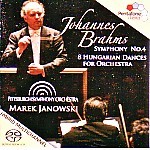
Symphony No. 4 in E minor Op. 98 / 8 Hungarian Dances for Orchestra
 $40.00
Out of Stock
$40.00
Out of Stock6+ weeks add to cart
BRAHMS
Symphony No. 4 in E minor Op. 98 / 8 Hungarian Dances for Orchestra
Pittsburgh Symphony Orchestra / Marek Janowski (conductor)
[ Pentatone SACD / Hybrid SACD ]
Release Date: Saturday 1 November 2008
This item is currently out of stock. It may take 6 or more weeks to obtain from when you place your order as this is a specialist product.
"Marek Janowski concludes his superb Brahms cycle with this unquestionably great performance of the Fourth Symphony. Everything about it is memorable, stylish, and characterful." (ClassicsToday 10 performance 10 sound)
"An American orchestra who speak Brahms as if it is their mother tongue. This is an often romantic, even lush, rendering of the Fourth Symphony. Menace and despair loom, but Janowski's Brahms seems determined to keep them at bay. Which adds a brooding tension to the work, a sense of struggling idealism. The Pittsburgh forces play their hearts out, rewarding their conductor with character and feeling. An endlessly absorbing disc."
Editor's Choice Gramophone March 2009
"Marek Janowski concludes his superb Brahms cycle with this unquestionably great performance of the Fourth Symphony. Everything about it is memorable, stylish, and characterful. The first movement opens at a perfect tempo, and if you don't thrill to the way the strings bloom lushly in their answer to the woodwinds' initial phrase at the start of the second subject, then you may need medical attention. This passage reveals just one of the factors that makes Janowski's Brahms so special: his ability to inflect a phrase, to linger lovingly for just the right amount of time without ever breaking the long melodic line or compromising momentum. There's another wonderful example at the start of the finale, where the bowed strings come in "largamente" for the first time. So many conductors equate "passacaglia" with rhythmic stiffness. Janowski shows us that you can vary the tempo and heighten the emotional impact without becoming eccentric or sloppy.
In the Andante, Janowski once again finds an ideal tempo (truly "andante moderato" and not "adagio"), and he secures amazingly beautiful playing from the Pittsburgh strings and winds (clarinets and flutes, especially). When the "big tune" returns in the recapitulation, it has a positively Tchaikovskian fervor. The orchestra's glorious horn section really comes into its own in the scherzo, but then, this is truly great Brahms playing--warm, idiomatic, perfectly balanced, and rhythmically true, just like the conducting. The coupling consists of all the Hungarian Dances orchestrated by either Brahms himself or Dvorák, and they make a wonderful encore. Superbly realistic engineering in all formats provides the icing on the cake. Taken as a whole, this Brahms cycle belongs with the very finest (Levine, Klemperer, Dohnányi), and stands in a class of its own on SACD."
(ClassicsToday 10 performance 10 sound)
Tracks:
Symphony No. 4
Hungarian Dance No. 1
Hungarian Dance No. 3
Hungarian Dance No. 10
Hungarian Dance No. 17
Hungarian Dance No. 18
Hungarian Dance No. 19
Hungarian Dance No. 20
Hungarian Dance No. 21



